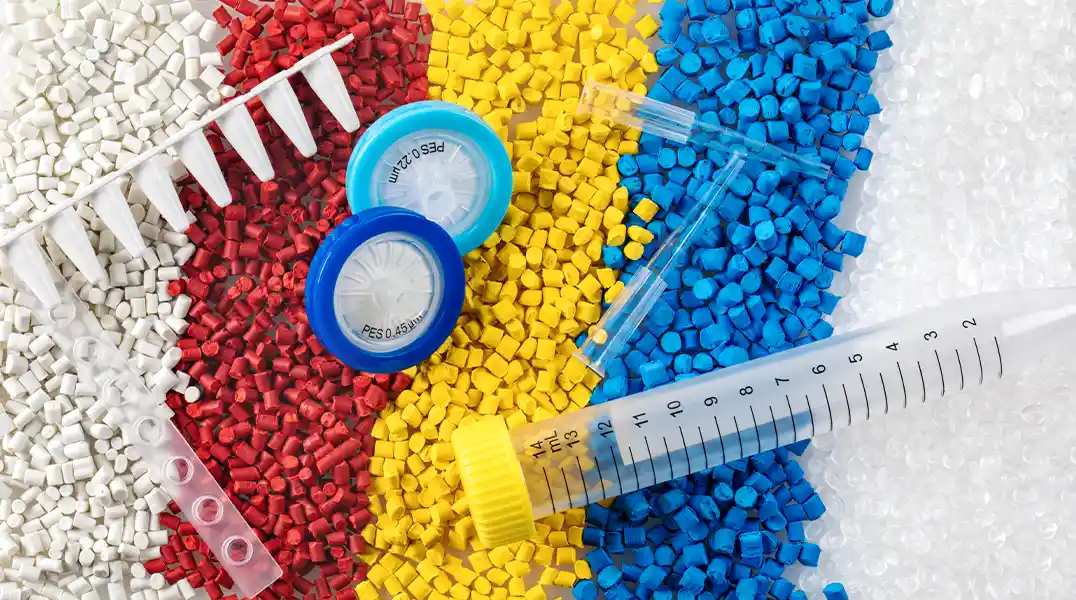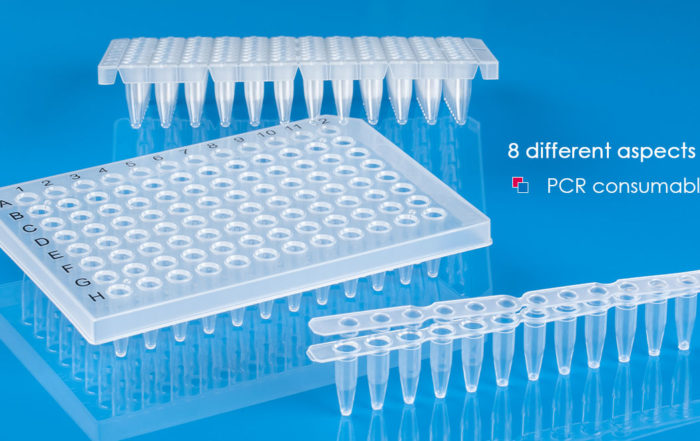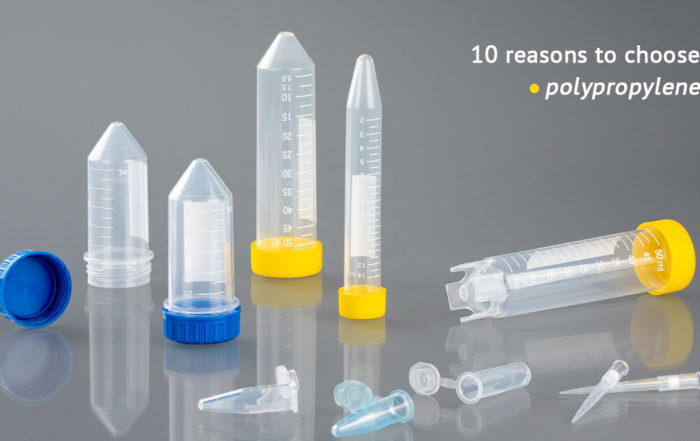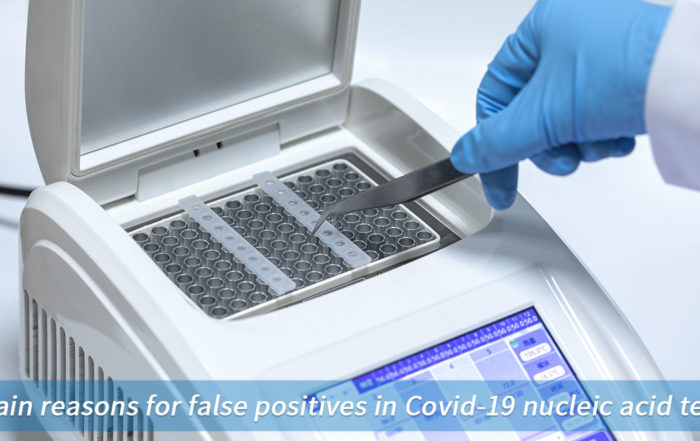What is the most common material in the laboratory? The answer is often “plastic”. Plastics are indispensable in modern laboratories, playing a crucial role in ensuring the efficiency, safety, and precision of various scientific processes. From sample storage to cell culture and chemical reactions, lab plastics have become an integral part of daily workflows due to their versatility and unique material properties. Each type of plastic offers specific advantages, making it suitable for particular applications.
This article delves into the most commonly used plastics in laboratories, exploring their fundamental properties, ideal use cases, and the products that leverage their strengths. By understanding these materials in detail, scientists and lab professionals can make informed choices, ensuring optimal performance and reliability in their experiments.
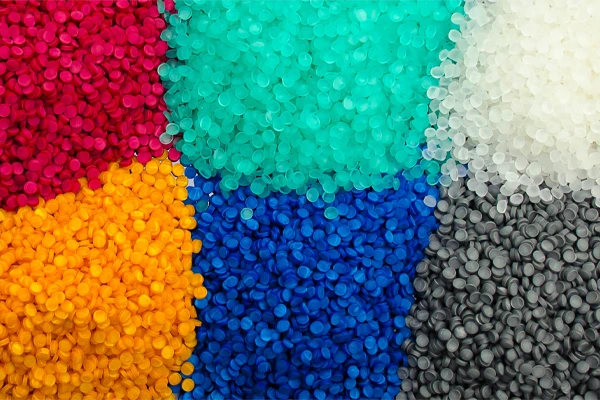
Polypropylene (PP)
Polypropylene (PP) is a versatile and widely used plastic in laboratories, known for its durability, chemical stability, and ability to withstand high temperatures. Its unique combination of properties makes it a reliable choice for various lab consumables and experimental applications.
Key Properties
Key Properties
High Heat Resistance: PP can tolerate temperatures up to 121°C, making it suitable for autoclaving and repeated sterilization without compromising its structural integrity. It remains stable under thermal cycling, an essential property for applications like PCR and hot liquid handling.
Chemical Stability: Resistant to a broad range of acids, alkalis, and organic solvents, PP ensures compatibility with most laboratory reagents. Its resistance to hydrolysis makes it ideal for use in aqueous solutions, even under elevated temperatures.
Low Moisture Absorption: PP is hydrophobic, minimizing water absorption and ensuring stability in humid environments or during prolonged exposure to liquid samples.
Impact Resistance: Despite being lightweight, PP demonstrates excellent impact resistance, reducing the risk of breakage during handling or centrifugation.
Non-Stick Surface: PP has a smooth, non-reactive surface that reduces sample adhesion, preventing contamination and facilitating efficient recovery of materials.
UV Sensitivity: While PP is durable, it can degrade under prolonged UV exposure. This is important to consider when using or storing PP items in environments with strong UV light.
Applications in Laboratory Settings
Applications in Laboratory Settings
Centrifugation: PP’s ability to endure high-speed spinning and mechanical stress makes it a standard material for centrifuge tubes.
Sample Storage: Its chemical inertness and low reactivity make it ideal for storing sensitive reagents, solvents, and biological samples.
High-Temperature Applications: PP consumables like tubes and plates are essential in PCR and other thermal cycling experiments.
Sterile Operations: Autoclavable PP products are indispensable for microbiology and molecular biology workflows.
Common Product Forms
Common Product Forms
Centrifuge Tubes: Available in volumes ranging from micro (0.5 mL) to large-capacity (50 mL) tubes, often featuring secure seals to prevent leaks.
Pipette Tips: Used in precise liquid handling, with options for sterile and non-sterile conditions.
Reagent Bottles: Designed for long-term storage of chemicals and solutions, resistant to chemical degradation.
Microplates and PCR Tubes: Critical for high-throughput assays and genetic analysis.
In summary, polypropylene stands out for its adaptability to diverse lab environments. Its heat resistance, chemical stability, and durability make it an essential material for ensuring accuracy, reliability, and safety in laboratory experiments.
Polystyrene (PS)
Polystyrene (PS) is a rigid, transparent plastic widely used in laboratories, particularly for applications requiring optical clarity and dimensional stability. Although it lacks the heat resistance of some other plastics, its unique properties make it ideal for a range of tasks, especially in biological research and sample storage.
Key Properties
Key Properties
High Transparency: PS is optically clear, allowing for easy visualization of samples, making it suitable for cell culture and spectrophotometry applications.
Rigid and Brittle: While PS provides excellent dimensional stability, it is less impact-resistant than other plastics like polypropylene. Careful handling is required to avoid cracking or shattering.
Chemical Compatibility: PS is resistant to aqueous solutions and some dilute acids and bases. However, it is sensitive to organic solvents, which can cause deformation or damage.
Smooth Surface: The smooth, hydrophobic surface of PS reduces sample adhesion, making it ideal for biological assays and non-stick coatings.
Low Heat Tolerance: PS is not suitable for autoclaving or high-temperature applications, as it softens and deforms at temperatures above 80°C(176°F). Even at operating temperatures of just 20°C (68°F), brittleness begins to increase.
Applications in Laboratory Settings
Applications in Laboratory Settings
Cell and Tissue Culture: The optical clarity and biocompatibility of PS make it a preferred material for cell culture plates, flasks, and petri dishes, enabling direct observation under a microscope.
Diagnostic Applications: PS is commonly used in assay plates and diagnostic kits, where its smooth surface supports precise liquid handling and reaction consistency.
Storage of Dry Materials: Due to its chemical inertness in dry conditions, PS is used for vials and containers to store dry powders or pellets.
Disposable Laboratory Items: PS is often chosen for single-use items like cuvettes and pipettes, where optical clarity and cost-effectiveness are priorities.
Common Product Forms
Common Product Forms
Polyethylene (PE)
Polyethylene (PE) is one of the most commonly used plastics in laboratories, particularly for applications involving storage and transport of samples and chemicals. Known for its excellent chemical resistance, flexibility, and ease of processing, PE comes in two main forms: low-density polyethylene (LDPE) and high-density polyethylene (HDPE), each with distinct properties suitable for specific lab applications.
Key Properties
Key Properties
Chemical Resistance: PE is highly resistant to acids, bases, alcohols, and other common laboratory chemicals, making it ideal for storing and handling chemical reagents and samples. It does not react with most solvents, ensuring the integrity of samples stored in PE containers.
Flexibility and Durability: LDPE is flexible and resistant to cracking, making it suitable for items that need to bend or stretch, like plastic bags and tubing. HDPE, on the other hand, is more rigid, providing better impact resistance and higher tensile strength.
Low Moisture Absorption: PE is hydrophobic, meaning it resists absorbing water. This property is particularly important in laboratory environments where moisture can compromise the integrity of certain materials.
Good Electrical Insulation: PE offers good electrical insulating properties, which makes it suitable for use in certain electrical and electronic applications, such as cables and insulating films.
Low Temperature Resistance: PE remains stable at low temperatures, making it ideal for use in cryogenic storage and low-temperature environments.
UV Sensitivity: Degrades when exposed to UV radiation over time, leading to brittleness and loss of flexibility. This should be considered when storing items in areas with direct sunlight.
Applications in Laboratory Settings
Applications in Laboratory Settings
Sample Storage: PE is widely used in containers for storing liquid and solid samples. Its chemical resistance and low moisture absorption make it suitable for long-term storage of a variety of substances. HDPE is often used for larger storage containers, while LDPE is used for smaller, flexible packaging like bottles or pouches.
Chemical Handling: PE’s resistance to a broad range of chemicals makes it an excellent choice for laboratory containers, bottles, and tubes used to hold reagents, solvents, and other chemicals.
Lab Consumables: LDPE is commonly used for disposable items like plastic bags, film wraps, and tubing that require flexibility, while HDPE is used for more rigid items like containers and bottles.
Cryogenic Storage: PE’s stability at low temperatures makes it ideal for storing biological samples or chemicals in ultra-low-temperature freezers or cryogenic tanks.
Common Product Forms
Common Product Forms
Plastic Bags and Film: Used for storing and handling samples, especially for liquid containment or short-term storage.
Bottles and Jars: Widely used for storing reagents, chemicals, and other laboratory materials. HDPE bottles are especially popular for their resistance to cracking and impact.
Cryogenic Vials: PE is often used in the form of small vials or storage containers for biological samples stored at low temperatures.
Tubing: Flexible LDPE tubing is used for transferring liquids and gases in various lab processes.
In summary, polyethylene offers an excellent combination of chemical resistance, flexibility, and durability, making it an ideal material for a wide range of laboratory applications. Whether in the form of flexible LDPE or rigid HDPE, PE is essential for ensuring the safe storage, transport, and handling of chemicals and biological materials in laboratory settings.
Polycarbonate (PC)
Polycarbonate (PC) is a high-performance, transparent thermoplastic known for its strength, optical clarity, and heat resistance. Due to its outstanding impact resistance and transparency, PC is commonly used in laboratory applications that require high visibility, mechanical strength, and durability. Despite being more expensive than some other plastics, its unique properties make it indispensable in various scientific fields.
Key Properties
Key Properties
High Impact Resistance: PC is known for its excellent impact strength, making it far more durable than other transparent plastics like acrylic. It is often used in applications where breakage would be a concern, such as safety equipment and containers that may be exposed to physical stress.
Optical Clarity: One of the standout features of PC is its high optical clarity, allowing for clear visibility of contents. This makes it ideal for use in containers, culture dishes, and safety equipment where visual inspection of samples or reactions is necessary.
Heat Resistance: PC can withstand temperatures up to 130°C, which is significantly higher than many other plastics like polystyrene. This heat resistance makes it suitable for use in autoclaving and applications that involve higher temperatures.
Chemical Resistance: While PC is resistant to a variety of chemicals, it is more susceptible to degradation from strong acids, alkalis, and certain organic solvents. Care should be taken when using PC in environments involving aggressive chemicals.
Dimensional Stability: PC offers good dimensional stability, maintaining its shape and structural integrity over time, even when exposed to heat or mechanical stress. This ensures that PC products retain their form and function under typical lab conditions.
Electrical Insulation: PC is an excellent electrical insulator, making it useful in laboratory applications that require non-conductive materials, such as electrical components or wiring.
Applications in Laboratory Settings
Applications in Laboratory Settings
Sample and Chemical Storage: PC’s high strength and transparency make it an excellent choice for storing chemicals, reagents, and biological samples. The clear nature of the material allows for easy identification and monitoring of stored contents.
Cell Culture and Biological Applications: The optical clarity of PC makes it an ideal material for cell culture dishes, flasks, and multi-well plates, as researchers need to observe cells and tissue growth under a microscope. Its strength also ensures that these items are durable and safe for use in the lab.
Safety Equipment: Due to its impact resistance, PC is commonly used for laboratory safety equipment, such as face shields, goggles, and protective barriers. The material’s clarity ensures unobstructed vision while providing physical protection.
Autoclavable Laboratory Ware: PC is often used in laboratory ware that requires autoclaving, such as petri dishes and laboratory containers. Its heat resistance allows it to be repeatedly sterilized without losing structural integrity.
Common Product Forms
Common Product Forms
Petri Dishes and Culture Flasks: Commonly used for microbiological cultures and cell growth studies, these products take advantage of PC’s clarity and durability.
Centrifuge Tubes and Bottles: Used for high-speed centrifugation, PC tubes offer superior strength to withstand the forces of centrifugation while maintaining their clarity for sample observation.
Safety Glasses and Shields: PC’s impact resistance and transparency make it ideal for protective eyewear and face shields in laboratory settings.
PCR Tubes: PC is often used for PCR tubes that need to withstand thermal cycling and provide clear visibility of reactions.
In summary, polycarbonate is a highly versatile plastic known for its impact resistance, optical clarity, and heat stability. It plays an essential role in laboratory applications that require transparency, strength, and durability, making it indispensable in fields ranging from microbiology to chemical processing.
Polytetrafluoroethylene (PTFE)
Polytetrafluoroethylene (PTFE), often referred to as Teflon, is a highly durable, non-reactive plastic known for its exceptional chemical resistance, low friction, and high thermal stability. PTFE’s unique properties make it a popular choice in laboratories, particularly for applications requiring resistance to aggressive chemicals, high temperatures, and friction.
Key Properties
Key Properties
Applications in Laboratory Settings
Applications in Laboratory Settings
Chemical Handling and Storage: Due to its unparalleled chemical resistance, PTFE is used in a wide range of lab equipment, including valves, tubing, seals, and gaskets that come into contact with corrosive substances. PTFE-lined containers and vessels are also commonly used for safely storing reactive chemicals.
Filtration Systems: PTFE is widely used in filtration membranes due to its non-stick surface and chemical inertness, making it ideal for applications where purity and resistance to contaminants are critical, such as in pharmaceutical and biotech laboratories.
Seals and Gaskets: The low friction and chemical resistance of PTFE make it a preferred material for seals and gaskets in laboratory equipment, where preventing leaks and ensuring tight seals is essential.
High-Temperature Equipment: PTFE’s high thermal stability makes it suitable for use in lab equipment that operates at elevated temperatures, including autoclaves, furnaces, and heat exchangers.
Coatings and Linings: PTFE coatings are applied to laboratory equipment and instruments to provide non-stick, easy-to-clean surfaces, ensuring efficient handling of materials and preventing contamination.
Common Product Forms
Common Product Forms
Seals, Gaskets, and O-Rings: PTFE is commonly used to create seals and gaskets that provide a reliable barrier against leaks, even under extreme chemical and temperature conditions.
Tubing and Hoses: PTFE-lined or full PTFE tubing is used for chemical transfer, offering unparalleled resistance to chemicals and heat.
Membranes and Filters: PTFE filters are employed in laboratory filtration systems due to their resistance to solvents and ease of cleaning.
Non-Stick Coatings: PTFE coatings are applied to laboratory surfaces to prevent adhesion and ensure easy sample handling and removal.
In summary, PTFE is an exceptional plastic with remarkable resistance to chemicals, heat, and friction. Its non-stick, low-friction surface, along with its electrical insulation and durability, makes it indispensable in a variety of laboratory applications, from chemical handling and storage to filtration and high-temperature equipment. PTFE’s versatility and resilience make it a top choice for labs that require high-performance materials under extreme conditions.
Polyvinyl Chloride (PVC)
Key Properties
Key Properties
Chemical Resistance: PVC demonstrates good resistance to a wide range of chemicals, including acids, alkalis, and salts, making it suitable for handling many laboratory reagents. However, it is not resistant to strong solvents like ketones or aromatic hydrocarbons, which can cause degradation.
Durability and Mechanical Strength: Rigid PVC is strong and durable, providing excellent resistance to wear and tear, making it ideal for structural applications like pipes, trays, and laboratory furniture. It is resistant to cracking and breaking under normal handling conditions, though it is more brittle at low temperatures.
Flexibility: Flexible PVC, often plasticized with additives, is extremely versatile and flexible, providing a durable yet pliable option for applications like tubing, bags, and sheeting. This flexibility is beneficial for tasks requiring ease of handling and movement.
Electrical Insulation: PVC offers good electrical insulating properties, making it suitable for use in laboratory settings that require non-conductive materials, such as in electrical wiring and cable coatings.
Low Moisture Absorption: PVC has low moisture absorption, helping to maintain its integrity and strength in humid or wet environments, which is crucial for items like lab trays and containers exposed to liquids.
Cost-Effectiveness: PVC is one of the most affordable plastics available, making it a popular choice in laboratory applications where cost efficiency is important without sacrificing performance.
Applications in Laboratory Settings
Applications in Laboratory Settings
Laboratory Equipment and Furniture: Rigid PVC is commonly used in the construction of laboratory furniture, trays, and cabinets due to its mechanical strength and ability to withstand everyday handling. PVC’s resistance to chemicals and low moisture absorption also makes it suitable for long-term use in laboratory environments.
Piping and Tubing: PVC pipes and tubing are widely used for fluid and gas transport in laboratory settings. They are commonly found in systems for water purification, gas supply, and chemical transfer due to their strength and resistance to many chemicals. Flexible PVC tubing is especially useful in applications where bending or flexibility is needed.
Film and Sheeting: PVC films and sheets are often used for protective barriers or surface coatings in laboratory environments. These can be used for sterile covers, work surfaces, and temporary barriers to prevent contamination.
Storage and Containment: PVC containers, bottles, and vials are used for storing liquids and reagents. Rigid PVC is typically used for larger containers and shelving, while flexible PVC is ideal for smaller, flexible storage options like bags for biological materials or chemical samples.
Protective Gear: Flexible PVC is often used in laboratory gloves, aprons, and other protective equipment due to its flexibility, durability, and chemical resistance. It is especially useful in environments where protection from chemicals is required.
Common Product Forms
Common Product Forms
Polyamide (PA, Nylon)
Polyamide (PA), commonly known as nylon, is a highly versatile and durable synthetic polymer widely used in laboratory applications. Its exceptional mechanical strength, chemical resistance, and wear properties make it a popular choice for applications requiring robustness and reliability. Nylon is available in various forms, including fibers, films, and molded components, each tailored to specific laboratory needs.
Key Properties
High Mechanical Strength and Durability: Nylon exhibits excellent tensile strength, impact resistance, and wear resistance, making it ideal for demanding applications where durability and load-bearing capacity are essential.
Chemical Resistance: PA is resistant to many chemicals, including oils, greases, and hydrocarbons. However, it is less resistant to strong acids and alkalis, which may degrade the material over time.
Low Friction and High Wear Resistance: With its low coefficient of friction, nylon is suitable for applications involving sliding or moving components. Its wear resistance ensures longevity in demanding conditions.
Moisture Absorption: Nylon tends to absorb moisture from the environment, which can affect its mechanical properties. While this characteristic can be a limitation, it also allows nylon to be more resilient and less brittle in dry conditions.
Thermal Resistance: PA offers good heat resistance, withstanding temperatures up to approximately 120°C. However, prolonged exposure to high heat can lead to degradation.
Electrical Insulation: Nylon provides excellent electrical insulation, making it suitable for use in electrical components and other applications requiring non-conductive materials.
Applications in Laboratory Settings
Applications in Laboratory Settings
Mechanical Components: Nylon’s strength and wear resistance make it ideal for laboratory equipment components, such as gears, bushings, and rollers, where high mechanical performance is required.
Filtration and Separation: Nylon membranes are widely used in laboratory filtration systems for liquid and gas filtration. These membranes are chemically stable and capable of filtering a wide range of substances, making them suitable for pharmaceutical and biochemical applications.
Storage and Transport: Nylon’s strength and durability are leveraged in the design of storage containers, tubes, and fittings, especially those that need to handle moderate mechanical loads or impacts during transport.
Protective Equipment: Nylon’s flexibility and strength make it a material of choice for protective gear such as gloves and aprons, particularly in settings involving abrasive or mechanical risks.
Tubing and Connectors: Nylon tubing is frequently used for transferring liquids and gases, particularly in applications requiring flexibility, resistance to wear, and compatibility with oils or greases.
Common Product Forms
Filtration Membranes: Nylon membranes are popular in filtration units for their chemical stability and compatibility with various solvents.
Tubing and Fittings: Used in laboratory systems for transferring fluids and gases, ensuring durability and leak-proof performance.
Machined Parts: Components like gears, bearings, and rollers made from nylon are integral to many pieces of laboratory equipment.
Storage Containers: Rigid nylon containers are used for sample storage, offering strength and resistance to mechanical damage.
Nylon Fibers: Woven into fabrics for protective gear or laboratory tools requiring high strength and flexibility.
In summary, polyamide is a robust and versatile material that excels in applications requiring strength, durability, and chemical resistance. While its moisture absorption characteristics can influence its performance in certain conditions, its broad utility in filtration, mechanical components, and storage makes it an invaluable material in laboratory environments. Nylon’s ability to combine strength with flexibility ensures its ongoing relevance across diverse scientific fields.
Polyphenylene Oxide (PPO)
Polyphenylene Oxide (PPO) is a high-performance engineering plastic well-regarded for its excellent thermal stability, mechanical strength, and low moisture absorption. Although it is often blended with other materials like polystyrene (e.g., Noryl®) to improve processability and reduce cost, pure PPO retains a unique combination of properties that make it indispensable for specific laboratory applications.
Key Properties
Key Properties
Thermal Stability: PPO can withstand high temperatures, typically up to 200°C, making it suitable for applications that involve autoclaving or continuous exposure to elevated temperatures.
Mechanical Strength: The material exhibits high tensile strength and impact resistance, ensuring durability and reliability for components subjected to mechanical stress or frequent handling.
Low Moisture Absorption: Unlike many other plastics, PPO absorbs very little moisture, which contributes to its dimensional stability and prevents warping or degradation in humid environments.
Chemical Resistance: PPO is resistant to a wide range of chemicals, including weak acids, alkalis, and some organic solvents. However, its resistance to aggressive chemicals should be evaluated depending on the specific use case.
Electrical Insulation: With excellent dielectric properties, PPO is a strong candidate for use in electronic or electrical applications where insulation is crucial.
Dimensional Stability: The combination of thermal stability and low moisture absorption ensures that PPO maintains its shape and size over time, even in challenging conditions.
Applications in Laboratory Settings
Applications in Laboratory Settings
Common Product Forms
Common Product Forms
Instrument Casings and Housings: PPO is used in the production of durable and thermally stable casings for sensitive laboratory equipment.
Fluid Handling Components: Valves, pumps, and connectors made from PPO provide excellent chemical and mechanical stability, ensuring precision in fluid systems.
Sheets and Rods: PPO sheets and rods are used in custom fabrication, offering high stability for various laboratory constructions.
Electrical Components: Non-conductive connectors and structural parts in electronic laboratory instruments rely on PPO for its insulating properties.
In conclusion, polyphenylene oxide (PPO) is a premium material that combines strength, heat resistance, and chemical resilience. While it is often blended to improve manufacturing efficiency, the core properties of PPO make it a standout choice for applications requiring precision, reliability, and adaptability. From fluid handling systems to instrument housings, PPO’s exceptional characteristics ensure its relevance in a variety of advanced laboratory settings.
FAQs
1. What’s different between plasticware and glassware in the laboratory? And how to choose?
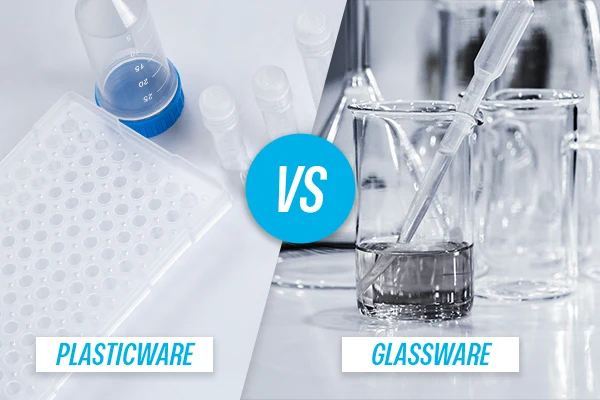
Plasticware and glassware are both essential in laboratory settings, but they differ significantly in material properties, usability, and cost. Plasticware, made from polymers such as polypropylene (PP), polyethylene (PE), or polystyrene (PS), is lightweight, shatterproof, and highly durable. This makes it an excellent choice for high-risk or routine tasks where breakage could pose a safety hazard. However, plastic materials generally have lower chemical resistance than glass and may degrade when exposed to certain organic solvents, such as acetone or chloroform. Glassware, on the other hand, is typically made from borosilicate glass or quartz, which are chemically inert and resistant to a broad range of substances, including strong acids, bases, and organic solvents. This chemical resistance, combined with its ability to withstand high temperatures, makes glassware ideal for applications involving boiling, heating, or autoclaving.
Another key difference is their response to temperature. Plasticware is generally not suitable for high-temperature applications, as most plastics melt or warp under heat, with some exceptions like PTFE. Glassware, however, excels in thermal stability, retaining its structural integrity in extreme temperatures and during rapid thermal changes. Additionally, glassware offers greater precision in quantitative experiments, as its rigid and non-deformable nature allows for more accurate volume measurements. While plasticware is cost-effective and disposable, reducing the need for cleaning and sterilization, glassware’s reusability makes it more economical for long-term use, despite its higher initial cost.
Durability and safety also differ between the two materials. Plasticware’s shatterproof nature minimizes the risk of injury or contamination from breakage, making it suitable for fieldwork, teaching laboratories, or environments where accidents are more likely. Glassware, while fragile and prone to breakage, offers a non-porous, scratch-resistant surface that reduces the likelihood of chemical interactions or contamination. This makes glassware the preferred choice for sensitive analyses or experiments requiring high chemical purity.
Choosing between plasticware and glassware depends on the specific requirements of your experiments. For applications involving strong chemicals, such as acids, bases, or organic solvents, glassware is the preferred option due to its superior chemical resistance. Similarly, when working with high temperatures, glassware’s thermal stability ensures reliable performance. Plasticware is more suitable for tasks requiring lightweight, durable, and shatter-resistant materials, such as handling biological samples, routine liquid storage, or fieldwork. It is also ideal for disposable applications where avoiding cross-contamination is a priority.
For laboratories operating on tight budgets, plasticware can provide an economical solution for routine tasks, while glassware should be reserved for high-precision or high-stress applications. Ultimately, a well-equipped laboratory will include both plasticware and glassware, allowing for flexibility and efficiency in meeting a wide range of experimental demands.
2. Can plasticware be sterilised for reuse?
Yes, plasticware can often be sterilized for reuse, but its suitability depends on the type of plastic and the sterilization method employed. Many plastic materials, such as polypropylene (PP) and polycarbonate (PC), are capable of withstanding autoclaving, a process that uses steam at high temperatures (typically 121°C). This makes them a practical choice for reuse in laboratory settings. However, not all plastics are suitable for autoclaving; materials like polystyrene (PS) or polyethylene (PE) can deform or melt under such conditions, limiting their reusability. For these materials, alternative sterilization methods, such as chemical agents like ethylene oxide, hydrogen peroxide vapor, or bleach solutions, may be effective, provided the plastic is chemically compatible. UV sterilization is another option that avoids heat and chemicals, though extended exposure can degrade the plastic, causing brittleness or discoloration over time.
When considering reuse, it is essential to evaluate the plastic’s durability under repeated sterilization cycles. While some plastics retain their properties after multiple cycles, others may degrade, leading to warping, loss of structural integrity, or reduced chemical resistance. This degradation can also result in surface imperfections, such as scratches or cracks, which may harbor contaminants and compromise sterility. For applications involving high-risk pathogens, biohazards, or critical sterility requirements, single-use plasticware is often preferred to ensure reliability.
Careful inspection and cleaning of plasticware are vital steps before sterilization. Residual chemicals or biological materials can interfere with the sterilization process, potentially leading to contamination. While reused sterilized plasticware can be appropriate for non-critical tasks, it is less ideal for applications demanding absolute sterility or precision. Ultimately, the decision to reuse plasticware should balance the material’s resilience, the demands of the task, and the risks associated with potential contamination or compromised performance.
3. What is the role of colored plasticware in laboratories?
3. What is the role of colored plasticware in laboratories?
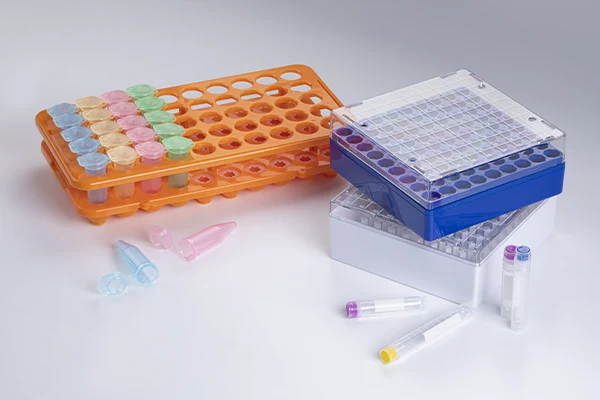
Colored plasticware in laboratories offers numerous advantages that contribute to improved efficiency, safety, and workflow organization. The use of distinct colors allows for easy identification of tools and their intended applications, reducing errors during experiments. For instance, specific colors might be designated for handling certain reagents, such as acids or bases, or for segregating tools used in DNA and RNA work. This minimizes cross-contamination risks and ensures that protocols are followed accurately.
Additionally, colored plasticware aids in inventory management by allowing quick visual assessments of available stock. Laboratories can use color-coded systems to distinguish between sterile and non-sterile items, or even between new and reused equipment. This organization helps streamline operations, especially in busy environments where efficiency is paramount.
Another critical benefit is enhanced safety. Brightly colored plasticware can act as a warning or reminder of hazardous contents, ensuring that potentially dangerous chemicals or biohazardous materials are handled with care. For instance, red or orange plastic items might indicate waste disposal tools or containers. Moreover, the psychological impact of colors can improve focus and clarity in fast-paced lab settings, aiding researchers in adhering to safety protocols.
In specialized applications, colors can also play a role in mitigating experimental biases. For example, translucent or non-colored plastic may reflect light differently compared to darker-colored items, potentially affecting light-sensitive assays. Choosing appropriately colored plasticware ensures consistency in results. Thus, the incorporation of colored plasticware into laboratory workflows represents a simple yet effective strategy to enhance accuracy, safety, and organization.
Conclusion
How to choose consumables for experiment: 8 different aspects of PCR consumables you need to know
Today, let's talk about a key element in PCR experiments - consumables. As a frequent PCR visitor, it is necessary to understand the characteristics and terminology related to PCR consumables. There are many PCR consumables [...]
10 reasons to choose polypropylene
What is PP? Polypropylene, or PP for short, is a semi-crystalline thermoplastic synthesized by Giulio Natta in 1954. It is one of the usual common polymer materials, with high impact resistance, strong mechanical properties, [...]
Main reasons for false positives in Covid-19 nucleic acid test
There are occasional false positives in COVID-19 Nucleic Acid tests. In addition to the contamination during the sampling process, what other factors could lead to "false positives" in the laboratory testing process? There are [...]
